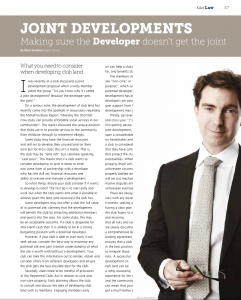This article appeared in the December 2014 issue of Club Life.
I was recently at a club discussing a joint development proposal when a witty member asked the group “Do you know why it’s called a joint development? Because the developer gets the joint!”
On a serious note, the development of club land has recently come into the spotlight in discussions regarding the McKell Institute Report “Meeting the Shortfall: How clubs can provide affordable social services in our communities”. The report discussed the unique position that clubs are in to provide services to the community from childcare through to retirement villages.
Some clubs may have the financial resources and skill set to develop their unused land on their own but for most clubs this isn’t a reality. That is, the club may be “land rich” but, relatively speaking, “cash poor”. This means that if a club wants to consider developing its land it needs to enter into some form of partnership with a developer who has the skill set, financial resources and ability to oversee and manage a development.
So what things should your club consider if it wants to develop its land? The first tip is to start early and work out what the club wants and what is possible to achieve given the land (and resources) the club has.
Some developers may not offer a club the full value of its potential site, claiming that the development will benefit the club by attracting additional members and guests into the area. For some clubs, this may be an acceptable outcome. If a club is desperate for short-term cash then it is unlikely to be in a strong bargaining position with a potential developer.
However, if your club is able to start early it can seek advice, consider the best way to maximise any potential site and gain a better understanding of what the site is worth with/without a development. Your club can take this information out to tender, obtain and consider offers from different developers and ensure the club gets the best possible deal for the club.
Secondly, clubs need to be mindful of provisions of the Registered Clubs Act in relation to core and non-core property. Early planning allows the club to consult and discuss the idea of developing club land with its members. Engaging members early on can help a club persuade members of the need for, and benefits of, a potential development.
The members may elect to declare the relevant site “non-core” or “non-core for a particular purpose”, which can provide an assurance to a potential developer that a potential barrier to the development has been removed. Many reputable developers are conscious that if the club fails to gain support from the members any proposed development may grind to a costly halt.
Thirdly, get everything in writing, dot your “i”s and cross your “t”s and don’t sign anything without first getting advice. Depending on the structure of a joint development, a relationship with a developer can span a considerable period of time. Merely operating on handshakes and loosely based agreements expose a club to considerable risks. Clubs need to ensure that they have comprehensive written agreements that protect the club for foreseen and unforeseen eventualities. When developing any property there will always be unforeseen circumstances. A properly drafted document will set out mechanisms to resolve disputes and deal with unforeseen eventualities.
There are always potential risks with any development. However, seeking advice early, having a clear plan of what the club hopes to achieve and ensuring that all risks and rewards are clearly documented in a comprehensive legally binding agreement ensures that a club is in the best position to mitigate those risks. A successful development on club land can be a richly rewarding experience for the club and the community and can mean that your members get a much better joint.
For more information contact Matt Goodwin or Anthony Gavan.
Click on the image below to see the article as it appeared in Club Life December 2014.
This article is intended to provide general information in summary form on a legal topic, current at the time of publication. The contents do not constitute legal advice and should not be relied on as such. Formal legal advice should be sought in specific circumstances.


